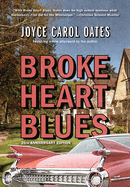
 The reissue of Broke Heart Blues, originally published in 1999, reintroduces readers to the breathtaking novel and includes a self-reflective afterword by its author, award-winning writer Joyce Carol Oates (Hazards of Time Travel, Butcher). Oates's contemporary classic about small-town obsession and nostalgia in the wake of a true-crime scandal will appeal to today's readers perhaps even more than before.
The reissue of Broke Heart Blues, originally published in 1999, reintroduces readers to the breathtaking novel and includes a self-reflective afterword by its author, award-winning writer Joyce Carol Oates (Hazards of Time Travel, Butcher). Oates's contemporary classic about small-town obsession and nostalgia in the wake of a true-crime scandal will appeal to today's readers perhaps even more than before.
John Reddy is only a teenager when he is tried for killing his mother's lover. Amid the trial's media circus, the local high school's swooning girls and overeager boys turn the quiet, enigmatic shooter into a heartthrob of epic proportions: the subject of speculative daydreams, the projection of personal desire, and the target of collective hero worship. Imagined to be gentle and misunderstood by some and discussed as a James Dean-esque hero by others, John remains an elusive presence in the life of his classmates, while he himself sags under the exhaustion of seemingly never being able to escape his fate.
Told in three parts, Broke Heart Blues uses its first portion to construct John Reddy as mythic vision through the collective first-person perspective of his admirers. In the most propulsive of the sections, this chorus allows the narrative itself to become "like background in a picture in which the foreground, the actual subject, is missing." While the high school girls' descriptions of John rise to orgasmic heights, the high school boys are just as enthralled with John ("Not that we were jealous. Maybe we were jealous....") as they are with his mother, Dahlia, as easily painted a victim as a femme fatale. In this prominent opening section, Oates's virtuosic control of pacing and voice constructs a tilt-a-whirl of mania, thrusting the narrative forward to the pulse of a small-town community's feverish heart.
The novel's second section slows to a gentler, more grounded pace as it explores John's later life as Mr. Fix-It. While this section provides both an intermission of sorts and a new emotional core to the novel's tension, the final act whips the story back into a collective frenzy as Oates uses a high school reunion as a setting to probe the dark hysteria underlying seemingly innocent nostalgia. In her afterword, Oates doesn't spell out any answers to the "murder mystery" she claims the novel is. Nevertheless, she does pull back the curtain a bit for readers to take a voyeuristic peek into inspiration for the novel's dream-like world. --Alice Martin, freelance writer and editor
Shelf Talker: Joyce Carol Oates's stunning novel about one town's ramped passion for a boy accused of murder, Broke Heart Blues, feels more resonant than ever in this reissue with a thoughtful afterword.

